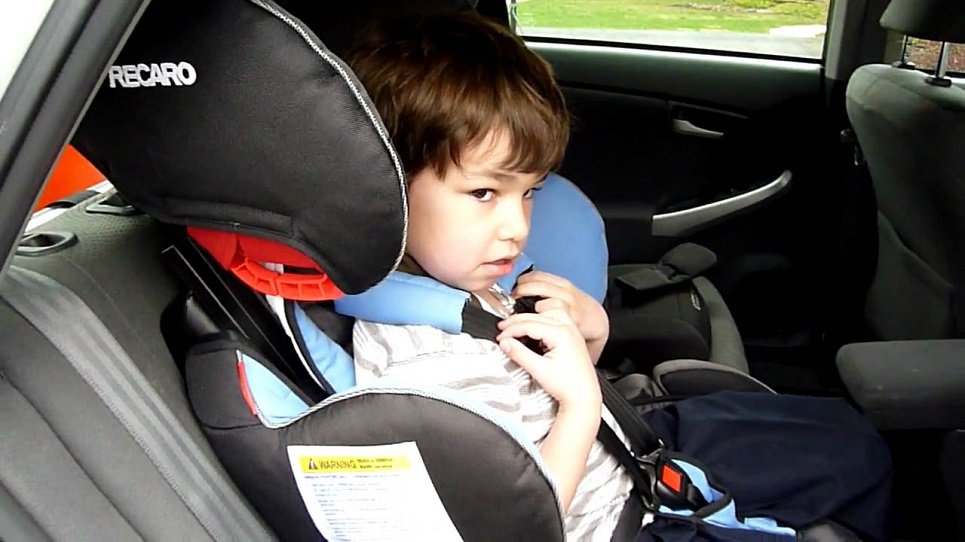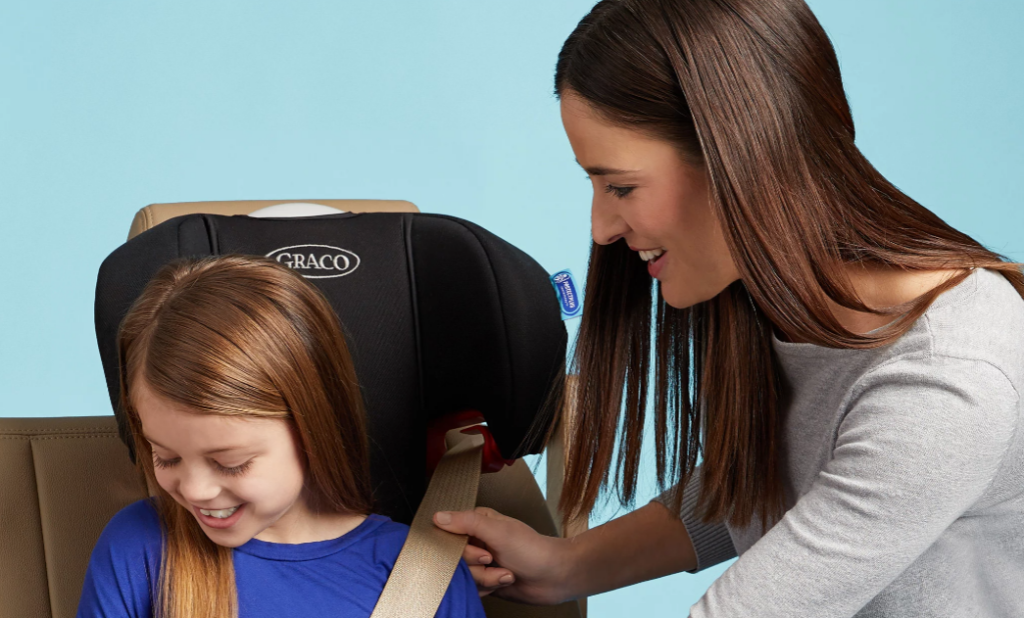- Car Seat Expiration Guide - November 4, 2022
- Best Britax Car Seats Guide - October 30, 2022
- Front Facing Car Seat Age Guide - October 29, 2022
Evidence indicates that riding in the rear-facing position protects children from head or spine injuries. That’s why the American Academy of Pediatrics and most car seat manufacturers recommend using rear-facing car seats for as long as possible. Rear-facing seats are mandatory in all states, but drivers don’t have a legal obligation to continue using them when transporting children older than 12 or 24 months.
This stands in contrast with recommendations provided by child passenger safety institutions that suggest toddlers aged three or four should use rear-facing seats.
One thing is clear. All new parents must restrain newborns in seats installed in the rear-facing position. The upper age limit for these seats isn’t strictly defined because it’s hard to predict how quickly a child will grow out of the seat. In this rear facing car seat age guide, I’ll walk you through vital aspects of these seats and recommend several models suitable for infants and toddlers.
Table of Contents
- 1 Bottom Line Up Front
- 2 What’s a Rear-Facing Car Seat?
- 3 Types Of Rear-Facing Car Seats
- 4 Weight And Height Limits
- 5 LATCH System, Harnesses, and Safety Features
- 6 Expiration Dates and Safety Guidelines
- 7 Prices and Warranties
- 8 Best Rear-Facing Car Seat Recommendations
- 9 1. Chicco KeyFit35 – The Best Infant Seat
- 10 2. Evenflo Tribute – The Most Affordable Rear-Facing Car Seat
- 11 3. Graco 4Ever DLX – The Best All-In-One Car Seat
- 12 4. Safety 1st Smooth Ride Travel System – The Best Stroller And Car Seat Combo
- 13 5. Britax B-Safe Endeavours – Rear-Facing Only Car Seat With The Best Safety Features
- 14 FAQs
- 15 Rear Facing Car Seat Age Guide: Final Thoughts
Bottom Line Up Front
Car seat law in all states is the same, to a certain degree. All infants must ride in rear-facing car seats from the moment they leave the hospital. The law mandates using these seats until the child’s first or second birthday depending on the state.
Still, NHTSA and other road safety agencies advise against rushing a child into a forward-facing seat and advocate the use of rear-facing seats as long as a child is under its height and weight limits.
| Recommended age | Legal age limit | Maximum weight | Maximum height |
| Up to 4 years | 1 or 2 years | 22 – 50lbs | 30 to 49 inches |
What’s a Rear-Facing Car Seat?
Brands like Chicco, Britax, or Nuna use several terms to label models that can be installed in the rear-facing position. This can be confusing for new parents who don’t have experience with safety car seats or know how to distinguish between different types of seats for infants and toddlers.
Furthermore, some models have rear-facing modes, allowing parents to choose the seat’s orientation. The one characteristic all rear-facing car seats have in common is that they’re suitable for babies that weigh 5lbs or more. Parents can use these seats to transport their newborns, regardless of the rear-facing car seat type they choose. The legal age limit when drivers can stop using a rear-facing seat varies from state to state.
So, if you live in California or Illinois, your child will have to be at least two years old before you can switch to a forward-facing position. On the other hand, under the Ohio car seat law, children older than twelve months can ride in front-facing seats.
Even though it isn’t mandatory, I think that the best way to ensure maximum safety is to resume using the seat in the rear-facing position until your child surpasses its weight and height capacities
Types Of Rear-Facing Car Seats
I felt a little bit out of my debt when I started searching for rear-facing car seats because I didn’t fully understand the differences between them. So, I speak from experience when I say that researching different categories of these seats will spare you the trouble of browsing aimlessly through hundreds of models.
I’ll break down the key traits of each rear-facing car seat type so that you don’t have to waste time learning about their differences.
- Infant car seats: Some manufacturers also label these seats as rear-facing-only because they can’t be installed in the forward-facing position. Most models have detachable bases and double as infant carriers. Infant seats made by Chicco or Britax are compatible with travel systems manufactured by these brands.
- Convertible: You can install a convertible seat in a rear-facing or forward-facing position, depending on the child’s weight and height. Still, these models can only accommodate children weighing less than 65lbs.
- All-in-one: Depending on the model, all-in-one car seats can have three or four modes. Hence, they’re suitable for infants, preschoolers, and school-age kids.
Weight And Height Limits
All rear-facing car seats are suitable for newborns that weigh over 5lbs and they don’t have the minimum height requirement. However, their upper height and weight limits depend on the seat type.
Infant seats have weight limits in the 22lbs to 35lbs range, so in most cases, a child cannot use them for more than two or three years. Their height limits are around 30 inches, which is slightly under the average height of a two-year-old girl.
Convertible models have higher height and weight limits in rear-facing modes, allowing you to keep using the same riding position until your child reaches the 40lbs or 50lbs mark. The maximum height these seats support in the rear-facing mode varies from 40 to 43 inches.
The weight and height limits of rear-facing modes of all-in-one safety seats are identical to those on convertible seats.
LATCH System, Harnesses, and Safety Features
Data released by the NHTSA a few years ago shows that 96% of new parents believe that their safety seats are installed correctly. However, the report published by the American Automobile Association indicates that parents often fail to fasten the seat properly, which increases injury risk.
Cars manufactured in the last two decades are equipped with LATCH anchors, so opting for a rear-facing seat that utilizes this installation system is usually the best option.
Still, I’d like to emphasize that some brands use alternative systems like ClickTight or SnugLock. Five-point harnesses are a standard feature on rear-facing car seats, and you should avoid models with three-point harnesses.
Other standard safety features include extendable headrests, anti-rebound bars, and multi-positional backs. In addition, most models are crash tested and feature several layers of shock-absorbing foam that protect the child from side impacts.
Expiration Dates and Safety Guidelines
The average lifespan of a rear-facing-only car seat is six years, while convertible and all-in-one models usually last eight to ten years. Hence, you won’t have to replace the seat you choose until your child grows out of it.
All brands advise parents to replace car seats after a crash, but the NHTSA’s guidelines indicate obtaining a new car seat following a slight accident isn’t necessary. Even so, having a seat inspected by a licensed technician after an accident, no matter how big or small, is advisable because it will help determine if its safety features are intact.
Using a rear-facing car seat after it expires isn’t against the law. Still, you may expose your child to danger by continuing to use an expired seat because its shock-absorption capacities or tightening systems may no longer function properly.
Prices and Warranties
The cost of rear-facing car seats depends on the brand, and the range of safety features a particular model offers. Most infant and convertible seats offered by Chicco, Nuna, or Diono cost more than $200, and neither of these brands should be your go-to option if you’re on a budget.
Evenflo and Safety 1st brands offer a broad spectrum of budget-friendly models that meet federal safety standards. These seats lack the advanced safety features provided by high-end models like the Nuna Rava or Britax Marathon, but they’re still durable and capable of keeping a child safe in an accident.
All-in-one models are usually more expensive than other rear-facing car seat types, but children can use them longer, which compensates for their seemingly high prices. The standard warranty period for a safety seat is one year, and only several brands offer longer warranties for their products.
Best Rear-Facing Car Seat Recommendations
1. Chicco KeyFit35 – The Best Infant Seat
Even though it is one of the brand’s flagship models, Chicco KeyFit35 isn’t more expensive than similar infant seats other companies offer. The seat has a detachable base, and you can quickly transform it into a carrier and mount it on one of the Chicco’s strollers.
KeyFit35 has LATCH connectors, a SuperCinch belt tightener, and the LockSure belt locking system that minimize the seat’s movement and safely restrain a child. The seat also has RidgeRight bubble-level indicators that show the angle at which it should be installed.
You can find more information about this infant car seat in our Chicco KeyFit35 review.
Pros
- This model features a canopy that protects a child from direct sun exposure
- The anti-rebound bar improves the seat’s stability
- The seat’s headrest is adjustable
- This model has six reclining positions
Cons
- It weighs more than 18lbs when fully assembled
- The seat can’t accommodate children taller than 32 inches
2. Evenflo Tribute – The Most Affordable Rear-Facing Car Seat
The Evenflo Tribute is one of the best convertible car seats in its price range. Its lightweight and compact design make it a great fit for small cars, while the LATCH connectors restrict its movement.
The five-point harness easily adjusts to the child’s height, ensuring a close fit. Moreover, the seat’s FAA-approved, and you can use it during commercial flights. Its fabric components are made of polyester, and they’re stain-resistant.
Evenflo Tribute doesn’t have a steel frame or an anti-rebound bar which affects its durability and stability.
Pros
- The seat’s maximum weight limit is 40lbs
- It has a cup holder
- Evenflo Tribute protects against side impacts
- An attractive price
Cons
- This model doesn’t have a bubble-level mechanism
- It has a manual re-thread harness
3. Graco 4Ever DLX – The Best All-In-One Car Seat
I prefer spending slightly more on an all-in-one model my child can use for ten years to buying a rear-facing car seat I’ll have to replace after a few years. So, it’s easy to see why Graco 4Ever DLX is one of my favorite 4-in-1 models, as it is designed to adjust to the child’s needs throughout their childhood.
The InRight LATCH mechanism makes the installation process straightforward because it generates a clicking sound that informs you the seat is correctly installed. The seat’s headrest can be placed in ten different positions, while its back has six reclining positions.
Pros
- The seat is tested for side and back impacts
- It has a rubberized harness storage
- RapidRemove seat cover is easy to clean
- The seat allows children to ride in rear-facing positions until they reach the 40lbs weight limit
Cons
- This 4-in-1 model cannot be used as a baby carrier
- The seat is heavy
4. Safety 1st Smooth Ride Travel System – The Best Stroller And Car Seat Combo
I know how tiring it can be to move a baby between a stroller and a car seat before and after every ride. That’s why I think getting the Safety 1st Smooth Ride Travel System can benefit new parents who spend a lot of time on the road.
The system features the brand’s onBoard 35LT infant car seat equipped with the QuickClick technology that enables parents to attach or detach the seat even while the child is asleep. The foldable stroller offers plenty of storage room, and you can fold it by simply lifting it.
Pros
- The seat’s canopy has a Peek-a-Boo window
- It has head and body support inserts
- The seat has built-in LATCH connectors
- The stroller has a braking system
Cons
- This travel system has a limited one-year warranty
- The seat’s base doesn’t have a shock-absorption mechanism
5. Britax B-Safe Endeavours – Rear-Facing Only Car Seat With The Best Safety Features
Besides being one of the brand’s premier infant car seats, the Britax B-Safe Endeavours is also a carrier compatible with several Britax strollers. The SafeCenter LATCH system enables you to fasten the seat’s base so it can’t move, while the Quick-Push LATCH connectors allow you to detach the seat from its base in seconds.
Dual side impact protection, steel anti-rebound bar, or SafeCell technology are among the model’s safety features that vouch for the passenger’s safety during a crash. B-Safe Endeavours has dual-level indicators and a reclining back, so finding the seat angle that fits your car shouldn’t be difficult.
Pros
- All fabric elements are breathable
- Excellent protection against side impacts
- It weighs 11.6lbs (without the base)
- The seat has six harness slot heights
Cons
- The seat expires after six years
- Most children will outgrow this seat after two years
FAQs
Question: Is it Safe to Use a Recalled Rear-Facing Car Seat?
Answer: Yes, it is. Car seats aren’t always recalled for safety reasons, and manufacturers usually send remedy kits that enable owners to continue using the seat.
Question: Where Can I Have My Rear-Facing Car Seat Checked?
Answer: Police stations, fire departments, pediatric hospitals, and community centers can help you get in touch with a CPS technician that can inspect your car seat or show you how to install it.
Question: Are All Infant Car Seats Compatible with Strollers?
Answer: Rear-facing-only seats aren’t always compatible with strollers, and you must check if the infant seat you’re interested in can be installed on a stroller.
Rear Facing Car Seat Age Guide: Final Thoughts
Over the years, I’ve learned that following the manufacturer’s instructions is the best way to keep my child safe and comfortable in traffic. So, I intend to keep using a rear-facing seat until my child is big enough to ride in the forward-facing position.
Although some states allow one-year-olds to sit in front-facing seats, I suggest waiting until your child turns three before considering changing its riding position. Buying an infant car seat might put pressure on you to switch to a forward-facing model if your child grows quickly.
Despite their high price, convertible and all-in-one models are in my opinion a better solution as their rear-facing modes have higher weight and height limits than infant car seats. Moreover, I don’t think inexpensive models that lack advanced safety features are a good choice for an infant, as they might offer underwhelming protection in crucial moments.













